|

MARKET SUMMARY
The Canadian stock market posted very strong returns this year.
Oil prices increased to record levels, and as a result, the energy
sector in the S&P/TSX Composite Index increased by 51.0% during
the year ending March 31, 2006. Overall, the Canadian stock market,
represented by the S&P/TSX Index, increased by 28.4% this
year compared to 13.9% the previous year.
The Canadian dollar continued to
strengthen against world currencies such as the euro, yen, pound
and U.S. dollar. Federal Government surpluses, rising oil prices,
robust growth forecasts and expectations of higher interest rates
helped fuel the increase in value of the Canadian dollar. At March
31, 2006, one U.S. dollar purchased $1.17 Canadian compared to
$1.21 at March 31, 2005. As a result, the value of the Fund’s
U.S. equity investments decreased when translated into Canadian
dollars, resulting in lower investment income.
The S&P 1500 Index, which tracks
the performance of the top 1,500 American companies, increased
by 13.0% over the year in U.S. dollars, compared to 7.2% the previous
year. In Canadian dollars, the increase in the S&P 1500 Index
was lower at 9.1% compared to negative 1.0% the previous year.
Currency movements had a negative impact, pulling returns from
U.S. investments down when translated into Canadian dollars.
Overall, non-North
American markets had healthy returns in 2005-06. The Morgan Stanley
Capital International Index for Europe, Australasia, and the Far
East, (MSCI EAFE Index), measures the performance of approximately
1,200 companies on 25 stock exchanges around the world. The index
increased by 20.0% in Canadian dollars compared to 6.2% the previous
year. Growth in demand from China continues to be strong, keeping
commodity prices firm.
.

NET ASSETS AND
TRANSFERS TO THE GENERAL REVENUE FUND (GRF)
Net assets represents the difference between the value of assets
held by the Fund and its liabilities. At March 31, 2006, the Fund’s
net assets at fair value totalled $14.8 billion (cost: $13.5 billion),
up $2.6 billion from $12.2 billion (cost: $11.4 billion) at the
end of the previous year. Since 1976, total transfers to the GRF
increased to approximately $28.6 billion.

CHANGE IN
NET ASSETS
The Heritage Fund accounts for its investments and investment
income on a cost basis of accounting, which excludes unrealized
gains and losses. Investment and investment income, on a fair
value basis, includes unrealized gains and losses. The investment
income, on a fair value basis, for fiscal year 2005-06 is $1,863
million (2004-05: $918 million).

INVESTMENT INCOME
In fiscal year 2005-06, the Fund recorded net income of $1,397
million, determined on a cost basis, compared to $1,092 million
in the previous year. Of the total income earned during the year,
$509 million (2004-05: $424) came from interest, dividends, real
estate income and security lending income, net of administrative
fees, and $888 million (2004-05: $668) came from net realized
gains from sale of securities and gains and losses from derivative
transactions.
The Government of Alberta financial
statements are prepared on a consolidated basis. Therefore, income
the Heritage Fund earned from Alberta provincial corporation securities,
totaling $15 million for the year is eliminated on consolidation.
On a consolidated basis, the Heritage Fund net income was $1,382
million.
Over five years, the Fund's cumulative
net income was $2,935 million compared to the cumulative budgeted
income of $2,936 million.
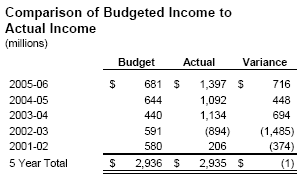
TRANSFERS
TO THE GENERAL REVENUE FUND AND INFLATION-PROOFING
In accordance with section 8 of the Alberta Heritage Savings
Trust Fund Act, the net income earned by the Fund, less an
amount retained for inflation-proofing, is transferred to the
Province's main operating fund, the GRF. Unrealized gains and
losses are not included in amounts transferred to the GRF. During
the year, $382 million was retained in the Fund to maintain its
value.
At March 31, 2006, outstanding
income transfers payable to the GRF totalling $77.7 million are
comprised of the following:

INVESTMENT
VALUATION
Investments and investment income are recorded on the financial
statements of the Heritage Fund at cost in accordance with government
accounting policies. The fair value of the Fund and its investments
are provided for information purposes. Management uses fair value
to assess the investment performance of the fund against market-based
benchmarks.
The Fund's policy is to write-down
the cost of those securities where the decline in value below
cost is not considered temporary. On a quarterly basis, management
reviews the Fund's investment portfolio to identify those securities
where the fair value has declined significantly below cost. The
Fund's net income for fiscal 2005-06 includes write-downs totaling
$43.1 million (2005: $34.4 million).
INVESTMENTS
Asset
Mix
The investment strategy is to invest in a diversified portfolio
to optimize long-term returns at an acceptable level of risk.
The policy asset allocation is reported in the Fund's 2006-09
business plan as follows:

Based
on the Heritage Fund 2006-09 business plan, the long-term policy
asset mix for fixed income securities decreases from 32.5% to
30.0%. The long-term policy mix for public equity investments
remains the same at 45.0%. Real estate investments remained unchanged
at 10.0% of total portfolio investments. Absolute return strategy
investments decrease from 7.5% to 5.0%. Private equity investments
decrease from 5.0% to 4.0%, while private income and timberland
investments increase to 4.0% and 2.0% respectively, of total portfolio
investments.
The
long-term objective is to increase alternative investments to
15.0% of the Fund's total investment portfolio. Alternative investments
include absolute return strategies, private equities, private
income and timberland. These investments are in a relatively illiquid
asset class and will require time to build up to their target
asset mix.
The
actual investment mix for fixed income securities increased to
33.3% from 32.7% at the beginning of the year. Public equity investments
decreased to 50.6% from 50.8%. Real estate investments decreased
to 9.6% from 9.7% of the Fund's total investment portfolio. Absolute
return strategies decreased to 3.8% from 5.0%. Private equities
increased to 1.7% from 1.3% and private income investments increased
to 0.6% from 0.5% at the beginning of the year. Newly initiated
timberland investments comprised 0.4% of the total portfolio.
New Investment
Products
In order to further diversify the Fund's investment portfolio,
new investments initiated during the year include timberland,
currency alpha and EAFE structured equity products (see Note 3
to the financial statements). Timberland products, responsibly
managed, are a renewable and sustainable resource. Demand for
timberland products has increased over the past decades, and is
expected to continue to grow in the future. Timberland investments
have historically provided attractive real rates of return. The
currency alpha investment earns returns through active currency
management, while the EAFE structured equity investment provides
exposure to non-North American equity markets primarily through
foreign equity index swaps.

HERITAGE
FUND RATE OF RETURN
The Fund posted an overall rate of return of 15.2% this year
compared to 7.7% last year. This year's return was 140 basis
points better than the Fund's policy benchmark return of 13.8%.
The performance of
the Fund is measured over the long-term. Over the past five-year
period, the fund generated a nominal annualized return of 7.1%.
compared to the expected nominal long-term rate of return of
6.7%. The nominal annualized return of 6.7% includes the real
rate of return of 4.5% plus annualized inflation of 2.2% over
a moving five-year period.
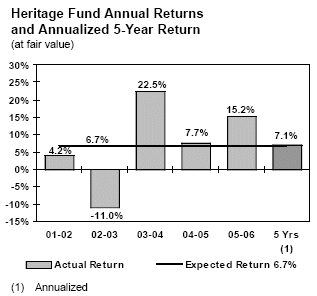
The performance of the
Heritage Fund investments is measured against various market-based
indices. Value added by investment management is accomplished
through asset mix decisions and security selection. The following
sections describe the performance of the Fund's major asset classes
in relation to their benchmarks.
Business
Plan Performance Measures
Time Weighted Rates of Return
(percent)
The following
table summarizes the Fund's actual returns and related benchmark
returns by asset class and for the Fund overall.

FIXED INCOME INVESTMENTS
The Scotia Capital (SC) Universe Bond Index measures the performance
of marketable Canadian bonds with terms to maturity of more than
one year. Over the past year, the SC Universe Bond Index increased
by 4.9% compared to 5.0% the previous year. The short term SC
91-Day T-Bill Index increased by 2.8% compared to 2.2% last year.

The
Fund's actual rate of return over the year from long-term Canadian
fixed income securities was 6.5%, 160 basis points better than
the benchmark SC Universe Bond Index. Over five years, the return
from long-term fixed income securities was 7.7%, or 70 basis points
better than the benchmark of 7.0%. The out-performance over one
and five years was largely due to better than expected returns
from directly held loans. The Fund's return from short-term securities
was 2.9% and 3.0% over one year and five years respectively.
The
Heritage Fund's fixed income portfolio is internally managed through
various pools and through direct holdings.
At March 31, 2006, the Fund's investment in fixed income securities
totalled 33.3% of total portfolio investments or $5.0 billion,
up from 32.7% or $4.0 billion at March 31, 2005.
The
Fund's Canadian fixed-income portfolio is comprised of diversified
holdings in corporate, federal, provincial and municipal bonds,
notes and short-term paper.

CANADIAN
EQUITY INVESTMENTS
The Canadian stock market had a strong year. The Toronto Stock
Exchange (S&P/TSX Index), which measures the performance of
Canada's top companies, reported a return of 28.4% for the year
ending March 31, 2006, compared to 13.9% last year. The energy
and materials sectors led all sectors with returns of 51.0% and
33.6% respectively. The consumer staples and information technology
sectors finished the year with the lowest returns of negative
7.3% and positive 4.7% respectively.

The Fund's Canadian equity portfolio is held in various investment
pools, which are managed by internal and external managers. Over
the year, the Fund's actual return from Canadian equities rose
by 28.8%, 40 basis points better than the benchmark S&P/TSX
Composite Index of 28.4%. Over five years, the Fund's return from
Canadian equities was 12.1% compared to the benchmark return of
11.7%.
At March 31, 2006, investments
in Canadian public equities totaled 17.0%, or $2.6 billion, of
the Fund's investment portfolio compared to 18.5%, or $2.3 billion,
one year earlier.
The following table
shows that 60% of the Fund’s public equity portfolio is
exposed to the financial and energy sectors of the Canadian stock
market.
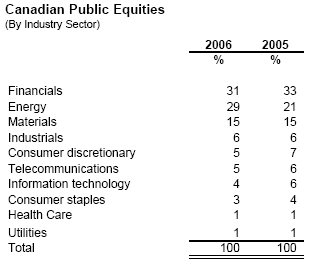
UNITED
STATES EQUITY INVESTMENTS
The U.S. equity market closed out the year posting a positive
return in U.S. dollars. The Standard & Poor's 1500 Index (S&P
1500), which measures the performance of the top 1,500 American
companies, rose by 13.0% this year compared to 7.2% the previous
year in U.S. dollars. When translated into Canadian dollars, the
index increase was 9.1% compared to negative 1.0% last year.

The Fund's actual rate of return over the
year from U.S. equities was 8.2% in Canadian dollars or 90 basis
points less than the S&P 1500 Index, primarily due to security
selection. Over five years, the Fund's U.S. equity portfolio returned
a negative 1.8%, 10 basis points less than the benchmark.
At March 31, 2006, investments in
U.S. equities totalled 16.8%, or $2.5 billion, of the Heritage
Fund investment portfolio compared to 16.2%, or $2.0 billion,
at March 31, 2005.

NON-NORTH
AMERICAN EQUITY INVESTMENTS
The non-North American equity market recorded healthy returns
this year. The Morgan Stanley Capital International Index for
Europe, Australasia, and the Far East (MSCI EAFE Index) measures
the performance of approximately 1,200 companies on 25 stock exchanges
around the world. The index increased by 20.0% over the year compared
to 6.2% last year, in Canadian dollars.
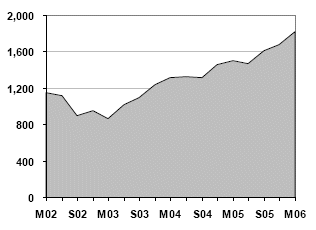

The Fund's actual return from non-North American equities was
24.2%, 420 basis points better than the benchmark MSCI EAFE Index.
Over five years, the Fund's non-North American equity portfolio
returned 4.7%, 140 basis points better than the benchmark MSCI
EAFE Index.
At March 31, 2006, investments in non-North American equities
totalled 16.8%, or $2.5 billion, of the Fund's investment portfolio
compared to 16.1%, or $2.0 billion, at March 31, 2005.

The Fund's non-North
American equity portfolio is invested throughout the world.
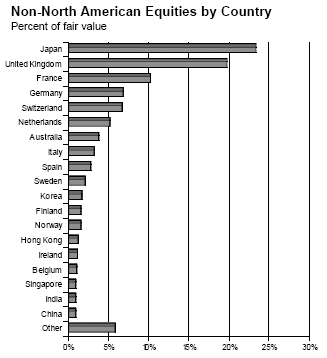
REAL
ESTATE INVESTMENTS
The Fund's real estate investments are held in the internally
managed Private Real Estate Pool and in the Foreign Private Real
Estate Pool. Real estate investments earned 20.7% over the year
compared to 17.0% the previous year. Over five years, real estate
earned 12.3%.

The real
estate portfolio is invested 50% in retail, 34% in office, 11%
in industrial and 5% in residential.
The following chart
shows the distribution of Canadian real estate by province.
.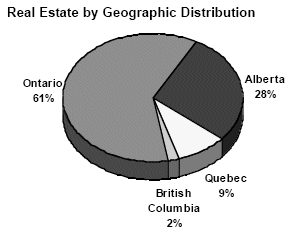
At March
31, 2006, investments in real estate totalled 9.6%, or $1.4 billion,
of the Heritage Fund investment portfolio compared to 9.7%, or
$1.2 billion, at March 31, 2005.
ABSOLUTE
RETURN STRATEGIES
Absolute return strategy investments encompass a wide variety
of investments with the objective of realizing positive returns
regardless of the overall market direction. A common feature of
many of these strategies is buying undervalued securities and
selling short overvalued securities. Over the year, absolute return
strategies generated a positive return of 5.2%, 490 basis points
less than the benchmark Hedge Fund Research Inc. (HFRX) Global
Hedged Index. The underperformance was due to the timing of a
benchmark change and given the stronger equity markets, the relatively
lower equity exposure of Absolute Return Strategies versus the
underlying benchmark.

At March 31, 2006, investments
in absolute return strategies totalled 3.8%, or $572 million,
of total Fund investments compared to 5.0%, or $611 million, at
March 31, 2005.
PRIVATE
EQUITY INVESTMENTS
At March 31, 2006, the private equities comprised a small portion
of the Fund's overall investment portfolio at 1.7%, or $258 million,
compared to 1.3%, or $153 million, at March 31, 2005.
During the year, the
private equity investments returned 18.4%, 820 basis points greater
than the benchmark Consumer Price Index (CPI) plus 8%. The outperformace
was due to appreciation in the underlying holdings reflective
of current market conditions

PRIVATE
INCOME INVESTMENTS
At March 31, 2006, the private income investments comprised 0.6%,
or $82 million, of the overall investment portfolio compared to
0.5%, or $61 million, at March 31, 2005. During the year, the
private income investments returned 21.3%, 1,310 basis points
greater than the benchmark CPI plus 6%. The outperformance was
due to income and valuation gains from external funds and co-investments.

TIMBERLAND
INVESTMENTS
The timberland product is a new investment this year. At March
31, 2006, timberland investments comprised 0.4%, or $56 million,
of the Fund's overall investment portfolio. During the past nine
months, timberland investments returned a negative 4.9%, 910 basis
points less than the benchmark CPI plus 4%. The underperformance
was due to lower than expected cash yield and the effects of foreign
currency exposure.
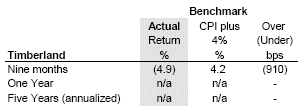

Administrative
Expenses
Internal management expenses and external management
fees are deducted directly from the income earned by pooled
investment funds. Internal expenses include expenses recovered
by Alberta Finance for management of the Fund and investment
pools. External fees include fees charged to investment pools
by external investment managers based on a percentage of net
assets under management at fair value and committed amounts
in the case of private equity and private income pools.
The Fund's total administrative expenses for the
year, including amounts deducted from the investment income
of the pooled funds, amounted to $44.37 million, or 0.3%, of
the Funds net assets at fair value compared to $34.64 million,
or 0.3%, of net assets last year.

Internal expenses increased by $1.181 million compared
to last year. External fees increased by $8.549 million compared
to last year. The increase is primarily due to external manager
fees associated with alternative investments such as absolute
return strategies, private equities, private income and timberland
investments, which have higher investment management fees.

|










